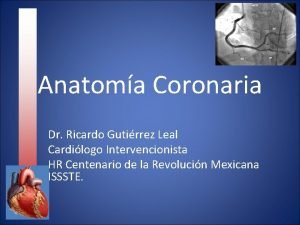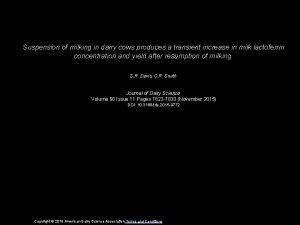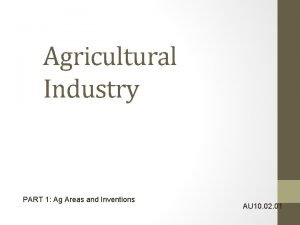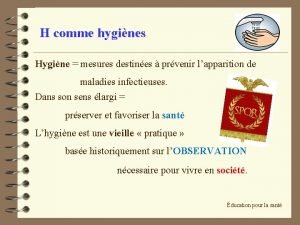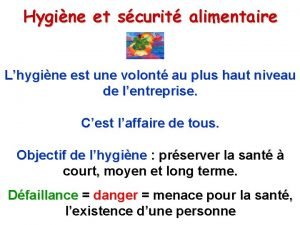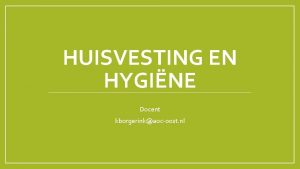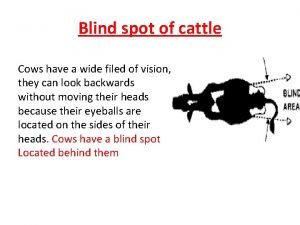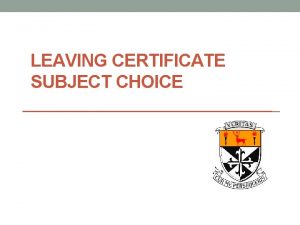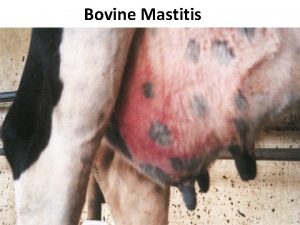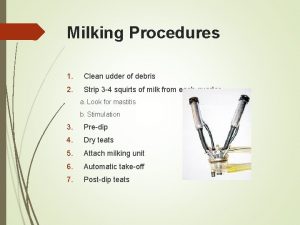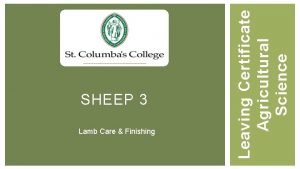Leaving Certificate Agricultural Science Milking Hygine The Udder













- Slides: 13

Leaving Certificate Agricultural Science Milking & Hygine

The Udder Suspended under the Cow. Divided into quarters. Can weigh up to 50 kg. Milk produced by groups of Alveolus tissue cells Ducts carry milk from these cells into the Gland Cistern, which can hold ½ litre milk This leads into the Teat Cistern and then through the Streak Canal to outside Udder has rich blood supply, as needs 500 kg of blood to create 1 kg of milk


Milk Let Down Milk let down is controlled by hormones Stimulation of the teats causes the release of hormone Oxytocin from the cow’s brain This allows milk to be released from the udder Any disturbances can cause the release of the hormone Adrenalin, which acts against Oxytocin, hence stopping milk let down Cows should always be milked calmly, in a routine manner, with no loud noises or discomfort/pain

Factors - Milk Yield 1. Age More milk produced up to the 5 th lactation then it decreases. This affects herd cull rates at around 20%. Frequency • More milking will force alveolus cells to produce more milk. However, regular intervals (10/14, 13/12, etc) twice a day is most economical for best yields Drying off • Cows need 60 days to recover before next lactation. Yields the following year decrease by 20– 40% if cow given less than this time. • 2. 3.

Factors - Milk Composition 1. Age % fat and protein content decreases with age Breed • Different breeds produce different milks e. g. Jersey high in fat, Holstein low in fat Feed • Good grass produces better milk. Fibre is required to produce two fatty acids, Acetate and Butyrate, essential to create fat. Stage of Lactation • % fat and protein is high, then decreases after 10 -12 weeks, then rises again at the end. % lactose decrease towards the end of lactation • 2. 3. 4.

Factors - Milk Composition 5. 6. 7. Stage/Completion of milking • % fat at start of milking is 1 -2%. This increase to the end of milking where %fat is at its highest. • Fat lodges in the alveolus and needs time to move. Incomplete milking results in more % fat at next milking. Milking Interval • There is an even content in milk in a 12/12 milking interval compared to a 14/10. • Higher volume of milk will occur after the 14 portion, resulting in a lower % fat content. Disease • Infections such as mastitis results in lower fat, lactose, and protein content, and higher white blood cell and antibody content

Milk Hygiene When milk is brought to a Dairy/Creamery to be processed it has to be checked • Hygiene quality tests are done first so the milk can be accepted • Milk quality tests are done to assess the value of the milk and the payment to the farmer, usually based on Fat and SNF content Milk is Pasteurised, which heats and cools the milk very quickly, to kill off microorganisms Milk is Homogenised, where Fat is broken up so it is evenly distributed throughout.

Factors - Milk Hygine 1. 2. 3. Total Bacterial Count (TBC) • TBC gives total number of bacteria cells present in the milk. Must be lower than 100, 000 cells per ml, over a 2 month average. • Caused by mastitis, dirty milking machines, dirty filters, milk kept at over 4 degrees C. Somatic Cell Count (SCC) • Measures the health of the udder. Counts the number of white blood cells. Must be lower than 400, 000 per ml, over a 3 month average • High values indicates udder has mastitis infection Antibiotics • Antibiotics are given to cows to treat bacterial infections, e. g. Mastitis. • However, they must be absent from milk as not allowed to be ingested by humans. Cows milk is withheld. • Antibiotics in milk can also kill good bacteria added to create cheese or yoghurt

Factors - Milk Hygine 4. 5. 6. Thermoduric test • Some bacteria can resist high temperatures when milk is Pasteurised. • A count of over 1000 per ml results is a fail. Sediment • Milk needs to be free from free floating particles. • Sediment present in milk indicates unhygienic milking practices e. g. teats aren’t cleaned properly, filters aren’t changed regularly. Temperature • Milk needs to be cooled to 4 degrees C within 30 mins. Otherwise, Lactobacillus bacteria turns the sugar (Lactose) into acid (Lactic Acid), giving sour milk. • Milk must be lower than 6 degrees C when collected. Quick litmus paper test can be done to check.

Milking Machine


 Cardilogo
Cardilogo Dirty poem about milking a cow
Dirty poem about milking a cow Suspension milking
Suspension milking Edmund quincy corn picker
Edmund quincy corn picker Importance of personal hygiene
Importance of personal hygiene Hygine
Hygine Hygine
Hygine Hygines
Hygines Diagramme le principe de la liaison froide réfrigérée
Diagramme le principe de la liaison froide réfrigérée Wikiwijs
Wikiwijs History syllabus leaving cert
History syllabus leaving cert Primary school leaving examination in chinese
Primary school leaving examination in chinese Clonakiltycc vsware
Clonakiltycc vsware Anti cow kicker diagram
Anti cow kicker diagram
